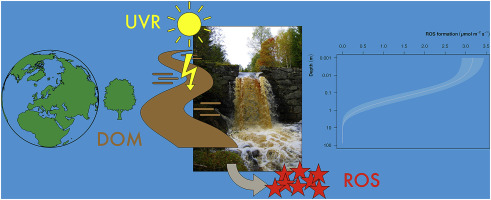Water Research ( IF 11.4 ) Pub Date : 2018-01-11 , DOI: 10.1016/j.watres.2018.01.025 Raoul Wolf , Jan-Erik Thrane , Dag Olav Hessen , Tom Andersen

|
Concentrations of dissolved organic matter (DOM) are increasing in a large number of lakes across the Northern hemisphere. This browning serves a dual role for biota by protecting against harmful ultraviolet radiation, while also absorbing photosynthetically active radiation. The photochemical activation of DOM and subsequent formation of reactive oxygen species (ROS) is a potentially harmful side effect, but can be difficult to measure directly in situ. In this study, we combine a data set of physico-chemical properties from 71 Nordic lakes with in vitro ROS formation quantum yields to predict ROS formations across a representative boreal ecosystem gradient. For the upper centimeter of the water column, we calculate ROS formations in the range of 7.93–12.56 μmol L−1 h−1. In the first meter, they range between 1.69 and 6.69 μmol L−1 h−1 and in the remaining depth the range is 0.01–0.46 μmol L−1 h−1. These ROS formations are comparable with previously field-measured hydrogen peroxide formation rates and likely affect both phyto- and zooplankton, as well as lake chemistry. Interestingly, wavelengths of the visible spectrum (>400 nm) contribute more than half of the overall ROS formation in surface-near water layers. The association between DOM and ROS formation was found to be two-fold. While DOM promotes ROS formation in the first centimeters of the water column, the shading effect of light attenuation overpowers this with increasing depth. In the context of water browning, our results indicate the emergence of an underestimated oxidative stress environment for lake biota in the upper centimeters of the water column.
中文翻译:

通过溶解有机物与吸收的太阳光子通量之间的相互作用模拟北部湖泊中的ROS形成
北半球大量湖泊中溶解有机物(DOM)的浓度正在增加。这种褐变通过防止有害的紫外线辐射,同时吸收光合活性辐射,对生物群系起双重作用。DOM的光化学活化和活性氧(ROS)的后续形成是潜在的有害副作用,但可能难以直接就地测量。在这项研究中,我们将来自71个北欧湖泊的理化性质数据集与体外ROS形成量子产率相结合,以预测代表性北方生态系统梯度上的ROS形成。用于水塔的上部厘米,我们计算ROS地层中7.93-12.56的范围 μmol L -1 h -1。在第一计量器,它们的范围1.69和6.69之间 μ摩尔大号-1 ħ -1和在剩余的深度的范围是0.01-0.46 μ摩尔大号-1 ħ -1。这些ROS的形成与以前现场测量的过氧化氢形成速率相当,并且可能影响浮游植物和浮游动物以及湖泊化学。有趣的是,可见光谱的波长(> 400 nm)贡献了近表面水层中总ROS形成的一半以上。发现DOM和ROS形成之间的关联是双重的。尽管DOM会在水柱的前几厘米促进ROS的形成,但随着深度的增加,光衰减的阴影效果会使其胜过。在水褐变的情况下,我们的结果表明在水柱上部厘米处,湖泊生物群的氧化应激环境被低估了。











































 京公网安备 11010802027423号
京公网安备 11010802027423号